Crab Apples: Nutrition, Varieties, Benefits, And Risks
Despite growing in the wild, it isn't less nutritional than its cultivated counterpart.
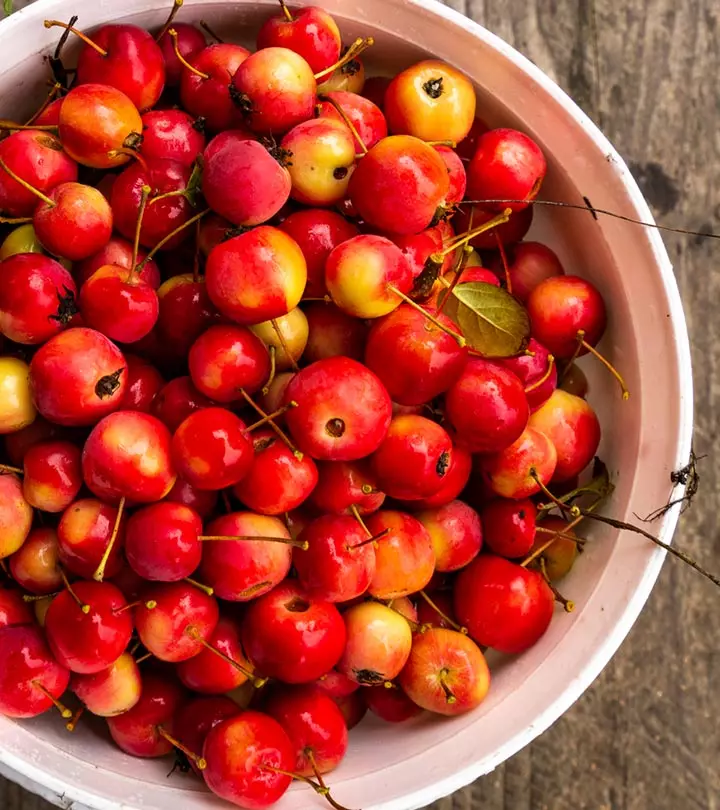
Image: Shutterstock
Have you ever come across wild fruits that look like apples but are too tiny to be apples? Well, chances are you have come across one of the many varieties of crab apples. With huge trees covered with gorgeous flowers in the spring and summer, the crab apple trees make for a beautiful addition to your backyard garden. But are they just good aesthetically, or can you eat the fruits of the crab apple trees as well? And if you can eat them, are they as nutritious and healthy as apples? Is there a proper way to consume them? In this article, we explore all these questions and more in detail about crab apples, their benefits, and potential risks. Read on to know all about these interesting fruits.

 Know Your Ingredient: Crab Apples
Know Your Ingredient: Crab ApplesWhat Is It?
Small, sour wild orchard apples, commonly used as decorative fruits.
What Are Its Benefits?
May prevent the proliferation of cancer cells, lower cholesterol levels, and improve skin issues.
Who Can Use It?
Can be consumed by all.
How Often?
Can be consumed daily
Caution
Avoid consuming its seeds or core as it may lead to cyanide poisoning.
In This Article
What Is A Crab Apple?
Crab apple does not refer to a particular species or variety of apples. These usually refer to wild apples that are small in size or underdeveloped. Crab apples, with a few exceptions, are usually sour to taste and make for good jams and jelly preparations. Crab apple trees also vary in their height, color, and taste of fruit. Some crab apple trees may not bear any fruit and just produce flowers in the summer season. Crab apples, known as wergulu in Old English, have been used in traditional medicine for ages. Anecdotal evidence suggests that they are one of the nine sacred remedies used for illness and infection mentioned in Nigon Wyrta Galdor, an Anglo-Saxon incantation.
Let’s explore a few popular varieties of crab apples.
Key Takeaways
- Crab apples are wild apples that come in different varieties, and not all types are edible.
- You have to eat four wild apples to equal the nutritional value of a medium apple.
- Crab apples have excellent antioxidant, anti-cancer, and cholesterol-lowering properties.
- However, their seeds contain cyanogenic glycosides, and eating them in large numbers can be fatal.
Types Of Crab Apples
While there are so many varieties and hybrids of crab apples, not all of them are edible. Some could just be ornamental and add to the beauty of the tree.
- Dologo
The Dologo variety of crab apple trees can grow up to a height of about 35 feet. These crab apples are mostly ornamental, but can also be used in jams and jellies. This tree is also one of the most disease-resistant among the various crab apple varieties. The tree produces larger crab apple fruits. It flowers into white blooms in the springtime, and the leaves turn a gorgeous yellow during the fall.
 Fun Fact
Fun Fact- The Whitney Flowering Crab
The Whitney Flowering Crab is a smaller tree that reaches a height of up to 16 feet. It produces pink and white flowers during the summers. These beautiful flowers also tend to attract bees and pollinators. This tree produces larger and sweeter apples when compared to other crab apple trees. These crab apples also work well for canning and pickling, as well.
- The Centennial Crab Apple
The Centennial crab apple is a dwarf variety of crab apple tree that reaches only a height of up to 8 feet. This variety of crab apples is also good for eating and makes for good jelly and apple butter preparations as well.
- The Chestnut Crab Apple
The Chestnut crab apple is well-suited for colder climates. This variety of crab apple fruits has a sweet, nutty flavor and is ideal for baking. The tree looks ornamental with its gorgeous colors in the autumn season, while it draws bees and pollinators during the summer months.
- The Hopa Flowering Crab
The Hopa Flowering Crab grows up to a height of 25 feet and produces beautiful pink flowers. It tends to be more vulnerable to diseases in comparison to other crab apple varieties.
- The Pink Spires Flowering Crab Apple
The Pink Spires variety of crab apple grows to a height of 15-feet and turns into lovely shades of bronze, orange, red, and marron during the cool fall season. as the weather starts to cool. However, the tree is mostly ornamental, with the fruit being inedible.
 Did You Know?
Did You Know?Are Crab Apples Edible?
Yes, most crab apple varieties are edible. All these vary in their taste and texture. While some can taste dry and bitter, others can taste sour and tart.
While you can eat most varieties of crab apples, their taste might not be very pleasant when eaten raw. Most taste best when made into jams and jellies.
How To Eat Crab Apples
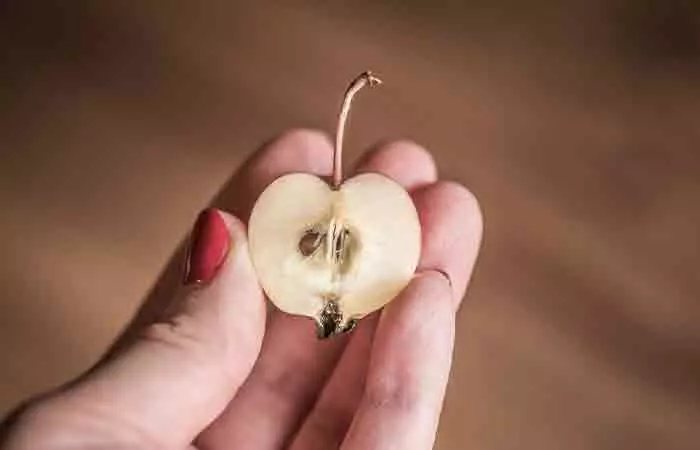
If you find a crab apple variety with an agreeable taste, you can eat it just like regular apples. Remember to cut in a way so as to remove the toxic seeds. The seeds in the core of apples contain cyanogenic glycosides, which form the toxin, cyanide (1). While you would need to eat a lot of crab apple seeds for it to be fatal, a little amount of consumption might lead to nauseai An uncomfortable feeling in the stomach that causes an urge to vomit but may not always lead to vomiting. It is often accompanied by sweating. and stomach upsets.
Now, for all other crab apple varieties that might be tart to taste, you could make them into jams, jellies, pickles, apple sauce, or butter to get the best out of their flavors. Let’s now have a look at what nutrients a raw crab apple provides you with.
Nutritional Profile
According to the USDA, 100g of raw crab apples have the following nutrients (2):
Water | 78.9g |
Energy | 76 kcal |
Protein | 0.4g |
Total lipid (fat) | 0.3g |
Carbohydrate | 20g |
Calcium, Ca | 18mg |
Iron, Fe | 0.36mg |
Magnesium, Mg | 7mg |
Phosphorus, P | 15mg |
Potassium, K | 194mg |
Sodium, Na | 1mg |
Copper, Cu | 0.067mg |
Manganese, Mn | 0.115mg |
Vitamin C | 8mg |
Thiamin | 0.03mg |
Vitamin A | 2µg |
Crab apples contain similar nutrients and benefits to regular apples. But you need to consume a lot of these to match the nutritional value of one apple. For instance, while a regular medium-sized apple could be around 3 inches in size, crab apples tend to vary between ¾ of an inch to 2 inches (3). Therefore, you would need about four crab apples to match the benefits of eating one medium apple. Should you have a crab apple tree in your garden? What are the benefits of growing one? Let’s understand further.
Benefits Of Growing Crab Apples
The benefits of apples are noted worldwide; however, crab apples have their share of perks. Given below are the benefits of crab apples.
- Rich In Phenolic Compounds With Antioxidant Properties

Crab apples are a good source of antioxidative phenolic compounds. The pulp of these fruits is especially rich in sugars and polyphenolsi Naturally occurring chemical compounds found in vegetables and fruits that defend the body against ultraviolet light damage. that are not only responsible for their taste and color but also help get rid of toxic free radicals with their antioxidant activities. Crab apples are richer than apples in their polyphenol content and show good potential for use in the health and skincare industries (4), (5).
- May Have Anticancer Properties
Crab apples, especially the red varieties, are believed to have more antioxidants and anticancer potential than the green varieties. Research suggests their potential antiproliferative role in inhibiting and restricting the growth and spread of cancerous cells with their pro-apoptotic activity. Bioactive compounds derived from crab apple leaves also exhibit anticancer potential on human cancer cell lines (6), (7), (8).
- May Help Lower Cholesterol
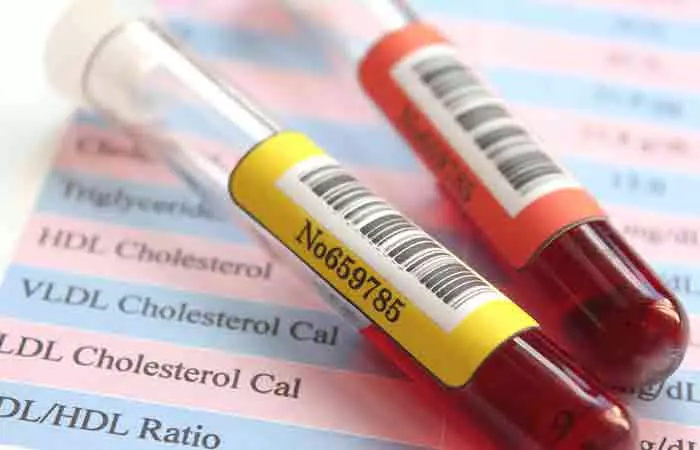
The bioactive components in crab apple fruit extracts might potentially help lower your blood cholesterol levels. Some scientific studies investigated the cholesterol-lowering effects of crabapple fruit extracts in high-fat diet-induced obese mice. The researchers found that extracts from five different crabapple varieties significantly reduced serum total cholesterol (TC) and low-density lipoprotein cholesterol (LDL-c) levels (9). They also helped lower triglycerides (TG) and improve fasting glucose levels (10). However, more research is warranted to establish the same for humans.
- Help In Pollination
Most crab apple trees bloom into gorgeous pink or white flowers during the summertime. These not only make your garden look beautiful but also help attract bees and birds. They help pollinate the other plants in your garden.
 Did You Know?
Did You Know?Well, as we see, crab apples can be similar to regular apples in their benefits and uses, but are there any risk factors? Let’s find out.
Precautions And Risks
Crab apples, being tiny versions of apples, may resemble some other wild fruits as well. For instance, Hawthorn berries are also often mistaken for crab apples due to their small size and bright red color. However, if you look carefully, they are rounder and have a more muted hue compared to crab apples. Fortunately, they are edible. However, that may not be the case for every other wild fruit you come across. So, you must be sure that what you have is a crab apple and not some dangerous fruit before taking the fateful bite. Here is how you can recognize crab apples:
- They are usually less than 2 inches in diameter and often resemble cherries.
- They may be green, yellow, or red and have a long stalk.
- They have oval leaves with serrated edges and a crooked tip.
- Both the leaves and fruit form in clusters
Once you are sure that the fruit you are picking is a crab apple, you must be careful about avoiding the seeds and core while eating the fruit.
Though the seeds contain cyanogenic glycoside, the precursor to the poisonous cyanide, it would take a lot of seeds to make you sick. Still, you must make sure to avoid them to prevent any unnecessary reactions.
You should also make sure that your pets or other animals don’t feed on these. As you cannot be sure of the quantity they consume and which might lead to potential poisoning.
Having said that, let’s understand the best practices to harvest and store these tiny apples to help you make the most out of them.
Harvesting And Storage
Just like the regular full-sized apple varieties, the crab apple trees also mature around late summer to mid-fall. The fruit usually turns red when it is ripe. To check the ripeness, you can cut it open at the equator. If the seeds inside are brown, it is ripe. Since these grow in the wild, or even in your backyard, you must be dressed appropriately to prevent mosquito or bug bites while plucking them off the branches. You can collect them in a canvas bag or basket, whichever is convenient for you.
Crab apples tend to bruise easily and could get spoiled within a day or two if not stored properly. You can have them as soon as they are harvested, or store them in the fridge to extend their longevity. You can also cook them into a variety of jams, jellies, and sauces, and preserve them for a longer time. We have listed two popular recipes below to help you get started.
Crab Apple Recipes
Here are some wholesome and delicious ways in which you can incorporate the goodness of crab apples into your lifestyle.
1. Crab Apple Jam
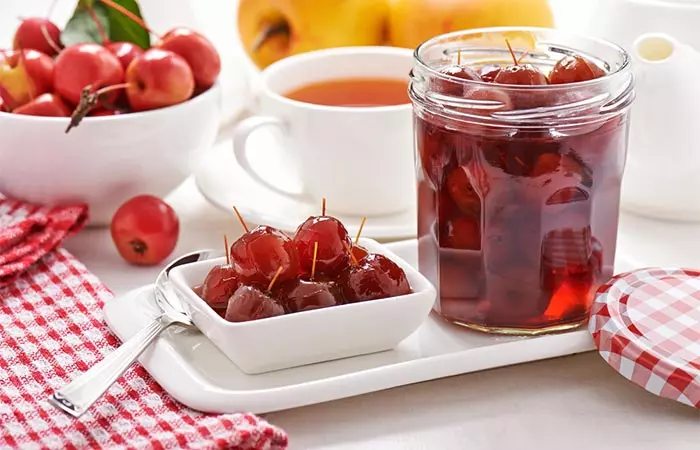
Ingredients
- Crab apples – 2.2 lbs
- Water- 2 cups
- Cane sugar – 2 ¼ cups
Instructions
1. Wash and clean the crab apples well.
2. Heat 2 cups (473 mL) of water in a large pot and add the crab apples in.
3. Let them simmer until they are soft and mushy, for about 35–40 minutes.
4. Mash the soft apples with an immersion blender.
5. Strain out the pulp through a fine-mesh sieve and remove the seeds and stems.
6. Take about 3 cups (237 mL) of this sieved pulp in a pot.
7. Add in the cane sugar.
8. Add vanilla, ginger, cinnamon, star anise, or any spices you like.
9. Simmer on medium heat for about 30 minutes, stirring frequently to prevent the mixture from sticking to the bottom of the pot.
10. The jam is done when it’s no longer runny.
11. Cool and pour into sterilized jars.
12. Refrigerate for later use.
2. Crab Apple Whiskey

Ingredients
- Crab apples – 750g
- Whiskey – 70 cl (700 ml)
- Sugar or honey – 5 tablespoons
- Fresh ginger slices – 3
- Cinnamon sticks – 2
Instructions
1. Wash and slice the crab apples into halves
2. Fill them into a 1-liter jar.
3. Pour in the whiskey all over the crab apples.
4. Add the sugar or honey and the ginger. You may add a cinnamon stick or a combination of your favorite spices.
5. Once the apples are well covered in whiskey, seal the bottle and set aside.
6. Let the whiskey infuse. The longer, the better.
Anne, a British farming owner who blogs about living on a farm, shared a post about crab apple season and what she likes doing with the fruits. She writes, “We mix crab apples with our eating and cooking apples to make a slightly tarter mix for cider making and last year I made a batch of crab apple pectin, which has been very useful for jam making this year. I’m toying with the idea of making Crab Apple Butter as I imagine that spreading toast with a spiced, fruity butter would be rather delicious (i).”
3. Crab Apple Chutney
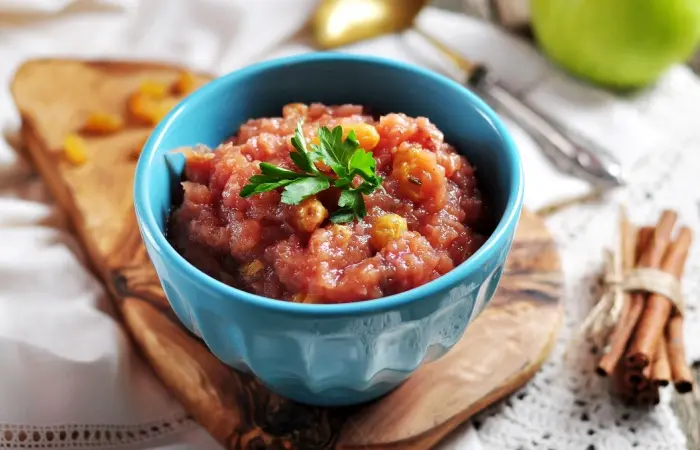
Ingredients
- Crab apples (unskinned and chopped) – 4 cups
- Onion (medium, finely chopped) – 1
- Apple cider vinegar – 1 cup
- Brown sugar – 1 cup
- White sugar – 1 cup
- Raisins – ½ cup
- Crystallized ginger (chopped) – ½ cup
- Cinnamon powder – ½ teaspoon
- Ground allspice – ½ teaspoon
- Ground cloves – ½ teaspoon
- Salt and black pepper – ½ teaspoon
Instructions
1. Mix the crab apples, onions, brown sugar, white sugar, apple cider vinegar, raisins, crystallized ginger, cinnamon, ground allspice, ground cloves, salt, and pepper together in a saucepan.
2. Place the saucepan over medium heat and let it cook, stirring occasionally and bringing it to a boil.
3. Turn the heat down to low, let the mixture simmer and cook for another 45 minutes to an hour, stirring occasionally to prevent it from sticking at the bottom.
4. Once the chutney thickens or the crab apples turn tender, remove it from the stove and allow it to cool.
5. Serve it with roasted meat, sandwiches, or cheese, or store it in an airtight jar and refrigerate.
Ideally, people make it during the fall season when you get ripe crab apples and allow it to infuse until Christmas. You can then have some rich, spiced crab apple whiskey ready for the festive season. You may leave it for up to five years for a more intense infusion.
Infographic: All You Need To Know About Crab Apples
Crab apples are small, wild apples used to make tart jellies and jams. They are rich in essential nutrients and bioactive compounds that may benefit your health in many ways. However, it is also essential to understand how to handle crab apples to ensure a safe and enjoyable experience. Check out this infographic to know more.
Some thing wrong with infographic shortcode. please verify shortcode syntaxTo Sum Up
Crab apples are miniature wild varieties of apples that have not developed completely. While they may not have a sweet flavor as usual apples, they are rich in healthy polyphenols and antioxidants. They usually have beautiful flowers that attract bees and birds in the summer and the leaves add gorgeous colors to your garden during the fall season as well. While few crab apples are purely ornamental and inedible, other varieties can be made into jams and jellies to enjoy their flavor and benefits.
Frequently Asked Questions
Can you make cider from crab apples?
Crab apples do not make good cider but can be used with other apples for more tannini Water-soluble polyphenols (a type of compound) present in plant foods that can bind with protein. It has antioxidant properties. .
Can crab apples be used for anything?
Crab apples are good for cooking. You may use them for desserts like pies, chips, tarts, and prepare jams and jellies.
Why is a crab apple called a crab apple?
It is said that the crab apple got its name as it appears in the cancer time in a year in late June and early July. Another explanation is related to the pattern of growth of crab apple trees. These trees can become twisted and gnarled and exhibit cribbled growth hence they are termed crab apples.
Are crab apples ornamental trees?
Yes, flowering crab apple trees are mostly used as ornamental trees. The blooms give a spectacular look in spring and the colorful fruits are a visual treat in the fall.
How long does it take for a crab apple tree to bear fruit?
Crab apple trees generally take 3-5 years to mature and bear fruit and they produce a high yield every year.
Illustration: Crab Apples: Nutrition, Varieties, Benefits, And Risks

Image: Stable Diffusion/StyleCraze Design Team
Discover the health benefits of crab apple fruits that will make you undoubtedly add them to your diet in the video below! Learn how this delicious fruit can improve your health and well-being. Check it out now!
Personal Experience: Source
StyleCraze's articles are interwoven with authentic personal narratives that provide depth and resonance to our content. Below are the sources of the personal accounts referenced in this article.
i. crab appleshttps://annewheaton.wordpress.com/2014/09/26/spiced-crab-apples/
References
Articles on StyleCraze are backed by verified information from peer-reviewed and academic research papers, reputed organizations, research institutions, and medical associations to ensure accuracy and relevance. Read our editorial policy to learn more.
- Cyanides in the environment—analysis—problems and challenges
https://www.ncbi.nlm.nih.gov/labs/pmc/articles/PMC5506515/ - Crabapples raw
https://fdc.nal.usda.gov/fdc-app.html#/food-details/171721/nutrients - Involvement of cell proliferation and cell enlargement in increasing the fruit size of Malus species – ScienceDirect
https://www.sciencedirect.com/science/article/abs/pii/S0304423805000658 - Characterization of phenolics amino acids fatty acids and antioxidant activity in pulp and seeds of high altitude Himalayan crab apple fruits ( Malus baccata)
https://pubmed.ncbi.nlm.nih.gov/29892117/ - Nutrient compositions and functional constituents of 12 crabapple cultivars (Malus Mill. species): Aptitudes for fresh consumption and processing – Yu – – Journal of Food Processing and Preservation – Wiley Online Library
https://ifst.onlinelibrary.wiley.com/doi/abs/10.1111/jfpp.15341 - (PDF) Phenolic Profile Antioxidant Activity and Anti-proliferative Activity of Crabapple Fruits
https://www.researchgate.net/publication/330891414_Phenolic_Profile_Antioxidant_Activity_and_Anti-proliferative_Activity_of_Crabapple_Fruits - Profile and antioxidant activity of phenolic extracts from 10 crabapples (Malus wild species)
https://pubmed.ncbi.nlm.nih.gov/24392851/ - Dihydrochalcone Compounds Isolated from Crabapple Leaves Showed Anticancer Effects on Human Cancer Cell Lines
https://pubmed.ncbi.nlm.nih.gov/26633321/ - Targeted isolation and identification of bioactive compounds lowering cholesterol in the crude extracts of crabapples using UPLC-DAD-MS-SPE/NMR based on pharmacology-guided PLS-DA
https://pubmed.ncbi.nlm.nih.gov/29232626/ - Crabapple fruit extracts lower hypercholesterolemia in high-fat diet-induced obese mice – ScienceDirect
https://www.sciencedirect.com/science/article/abs/pii/S1756464616302936
Read full bio of Vandana Gujadhur
Read full bio of Varsha Patnaik
Read full bio of Ravi Teja Tadimalla
Read full bio of Payal Karnik






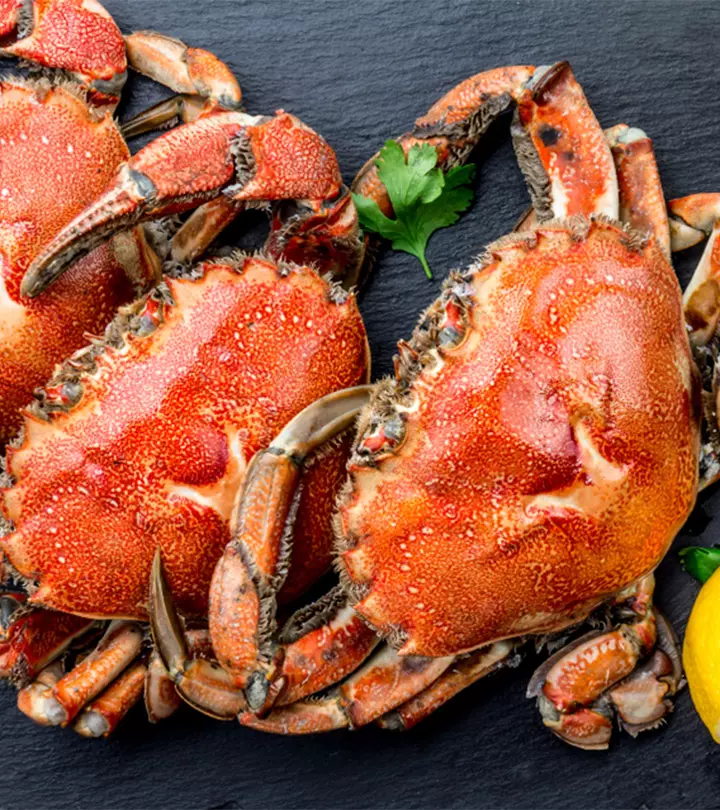
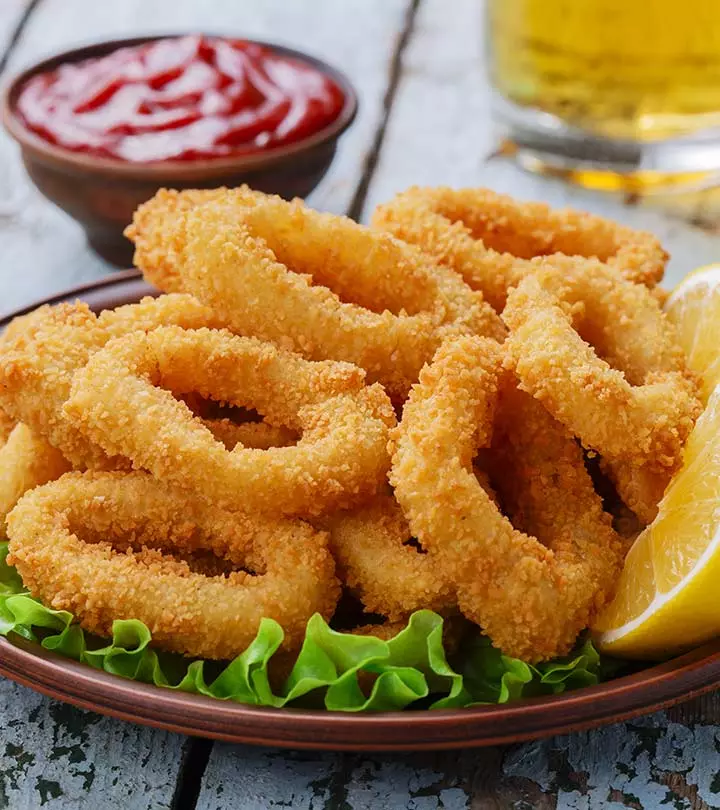
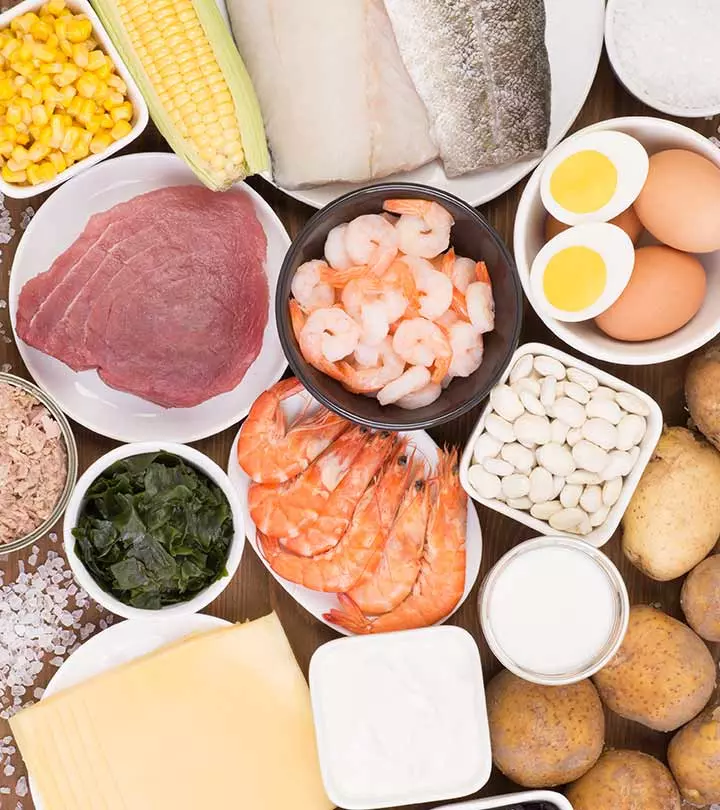
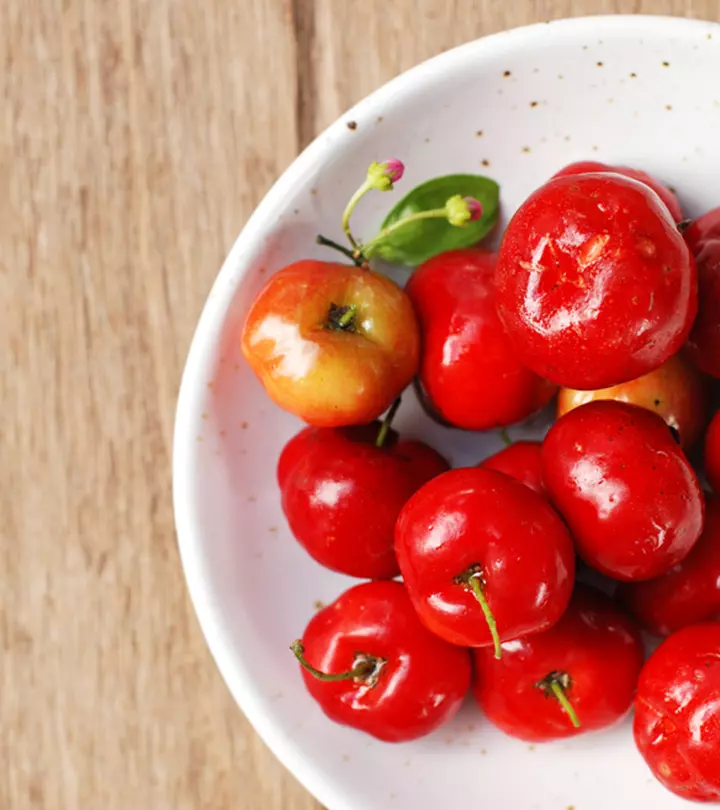
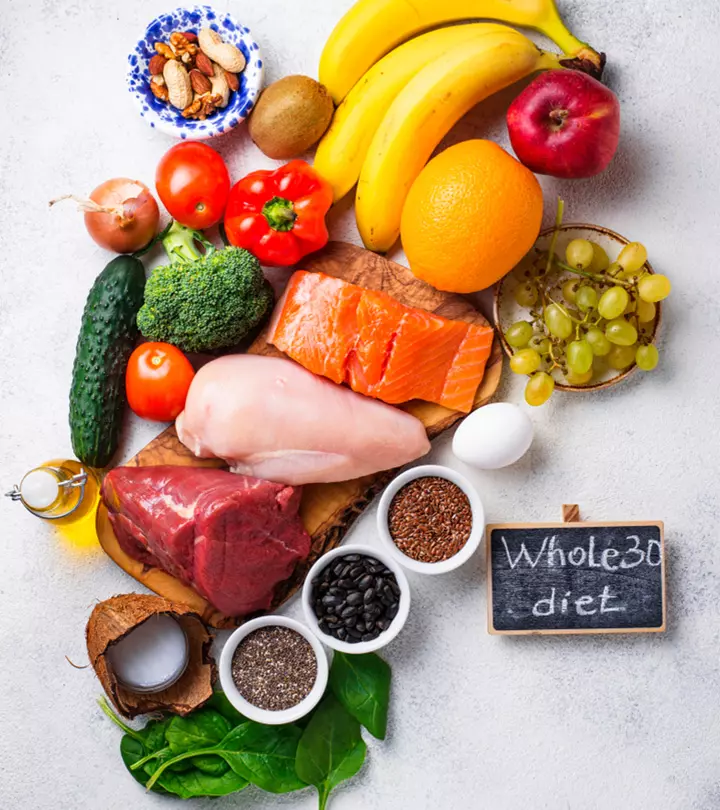

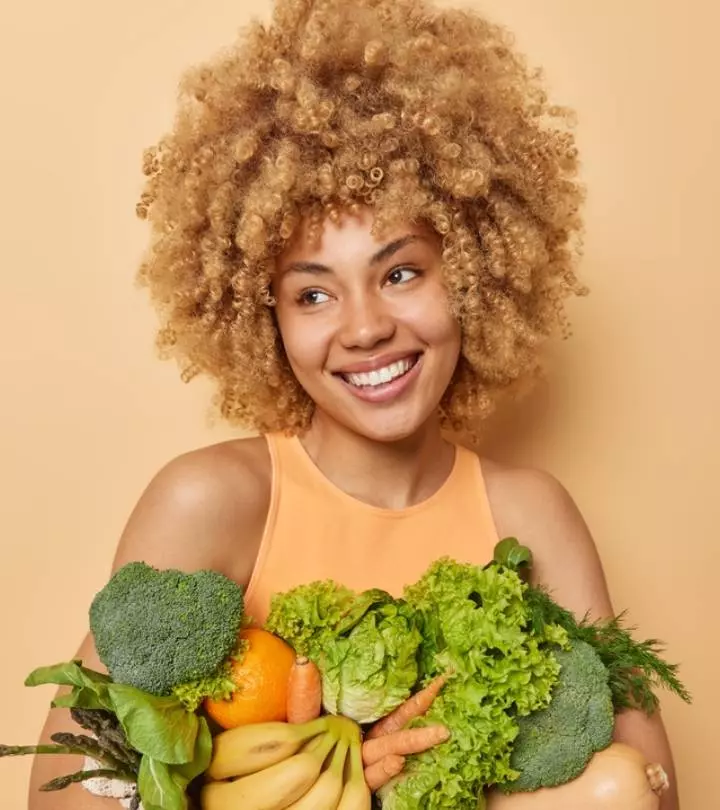


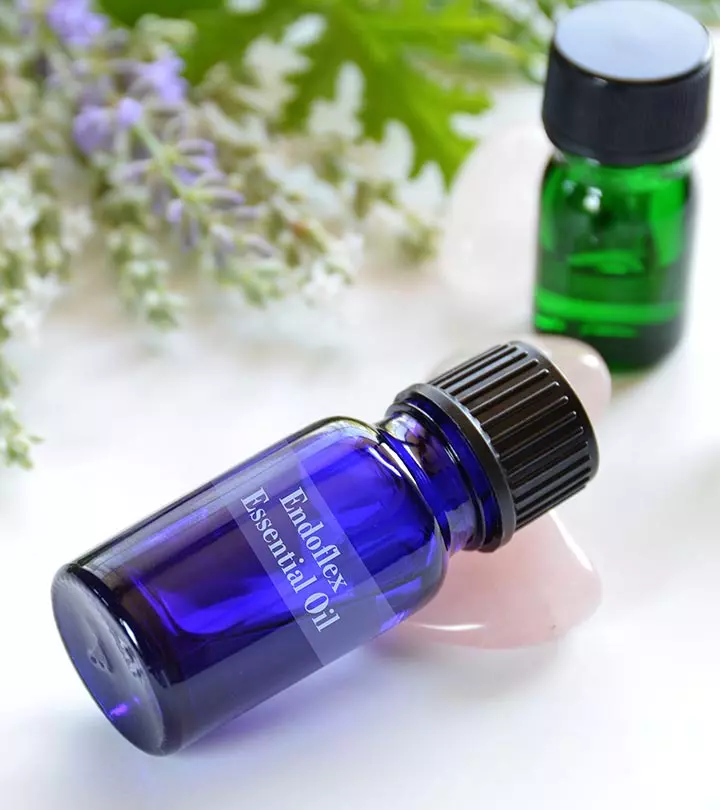




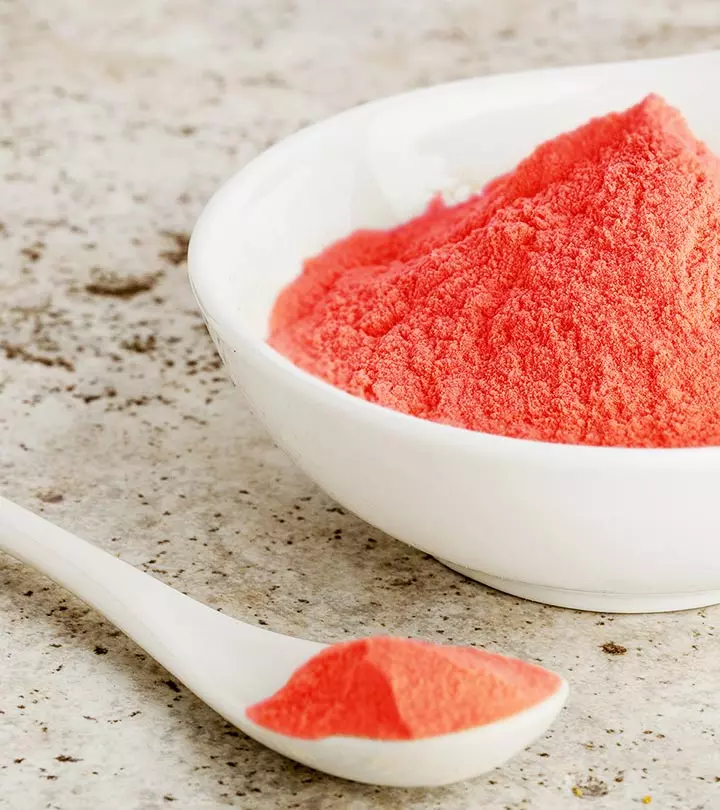

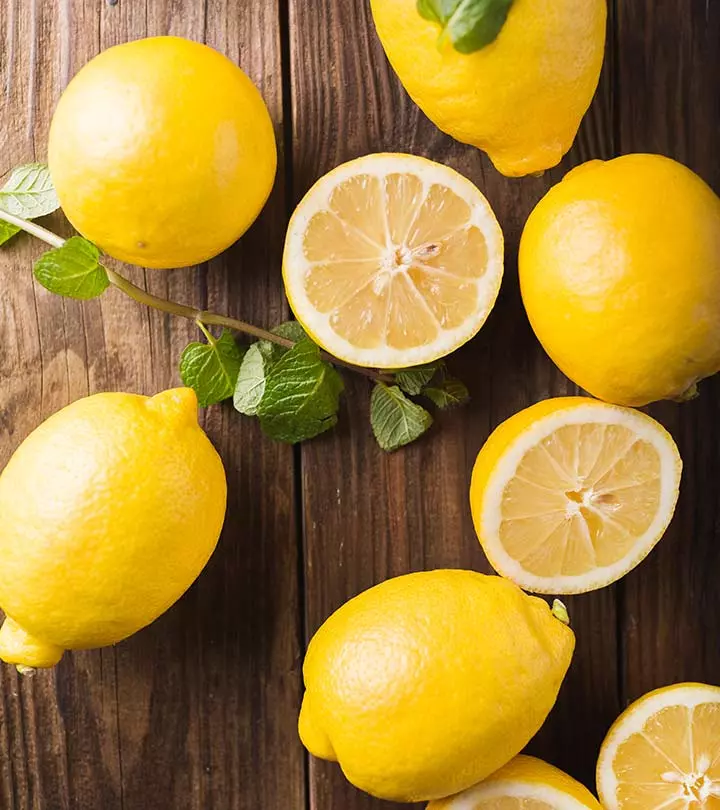
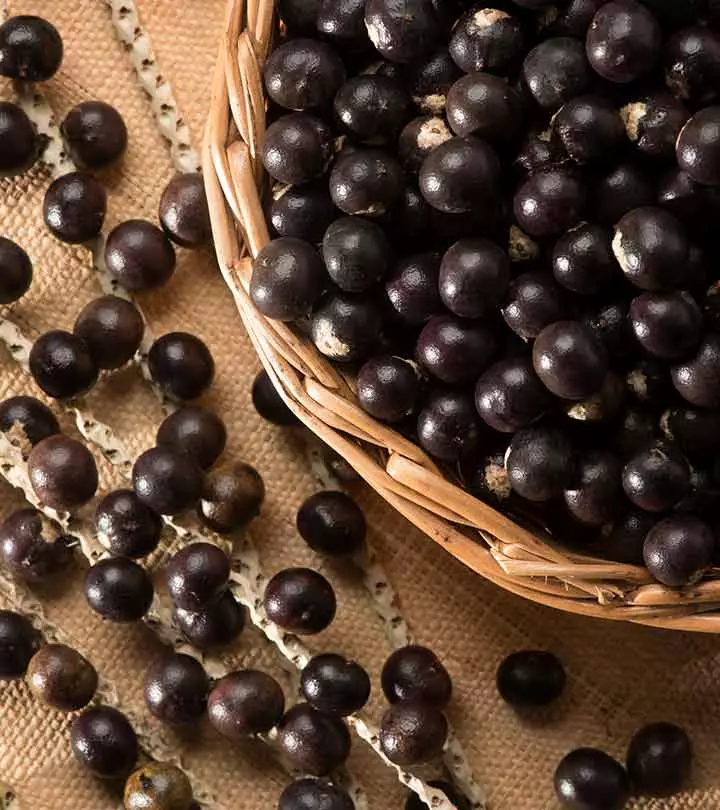
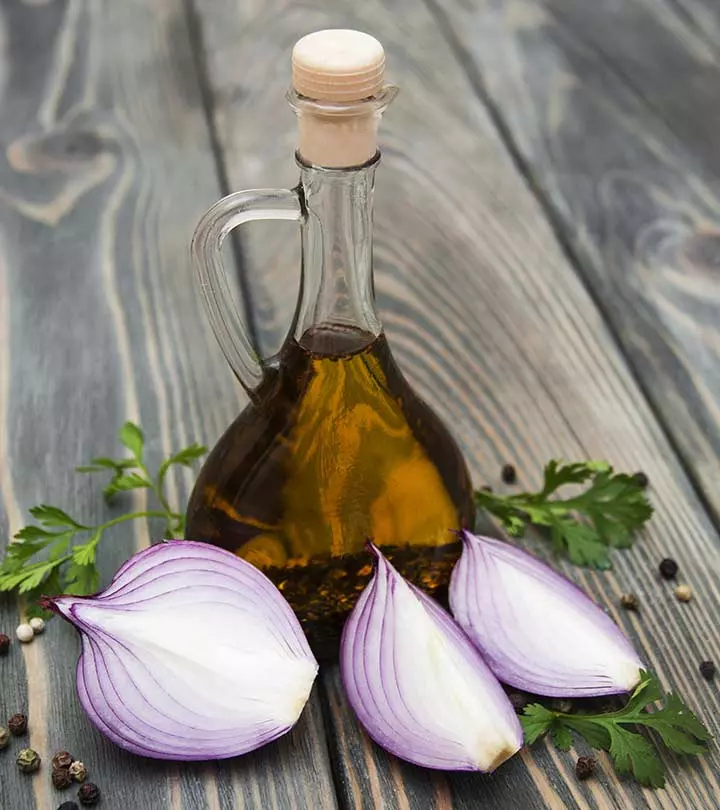
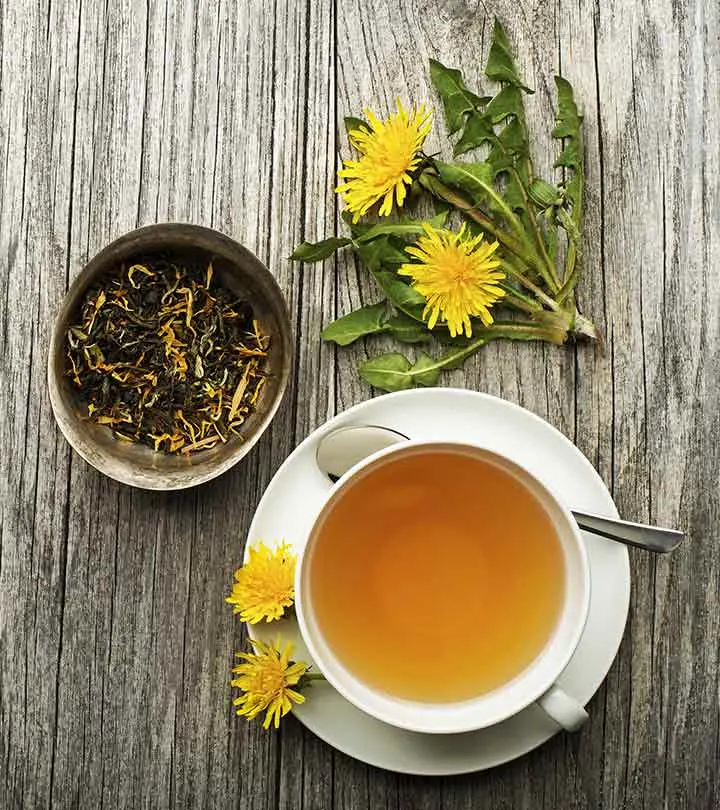

Community Experiences
Join the conversation and become a part of our empowering community! Share your stories, experiences, and insights to connect with other beauty, lifestyle, and health enthusiasts.